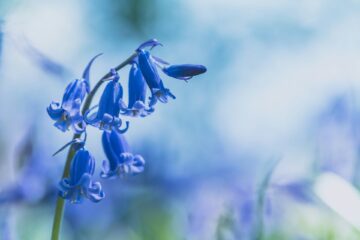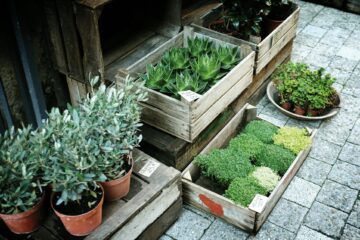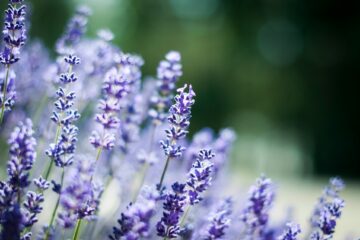What are Perennials and Annuals?
To decide the argument of perennials vs annuals you need to know about both types of pants.
Perennials are plants that live for more than two years. They go dormant in the winter and regrow from their rootstock each spring. Examples include hostas, daylilies, peonies, and many ornamental grasses. Perennials typically have a shorter blooming period but provide long-lasting foliage and structure in the garden.
Annuals are plants that complete their entire life cycle in a single growing season. They germinate from seed, bloom, produce new seeds, and then die off as the weather cools. Common annuals include petunias, marigolds, zinnias, and impatiens. Annuals provide vibrant colour and blooms for a few months before needing to be replanted each year.
Advantages of Perennials
Perennial plants offer several advantages for the gardener looking for low-maintenance beauty that returns year after year. One of the primary benefits of perennials is their longevity – these plants will come back reliably for multiple growing seasons, saving you the effort and expense of replanting annually. As perennials become more established in your garden over time, their root systems strengthen, allowing them to better withstand drought, pests, and other environmental stresses.
Another key advantage is the reduced maintenance required for perennial beds and borders. Once planted and established, most perennials need only occasional division, pruning, and other basic care to thrive. This frees up your time for other gardening tasks or simply enjoying your outdoor space. Many perennials are also relatively low-care in terms of water needs, fertilization, and pest management compared to annuals.
The consistency and permanence of perennial plantings also contributes to a cohesive, well-designed garden aesthetic. As these plants return reliably each year in the same spaces, you can craft a unified look and feel. Perennials often multiply over time through self-seeding or expanding root systems, filling in garden beds while providing seasonal interest through colourful blooms, foliage, and textures.
Advantages of Annuals
Annuals offer a delightful array of colours, textures, and forms that can completely transform the look of your garden each year. One of the biggest advantages of annuals is the incredible variety available, allowing you to experiment with different combinations and create striking displays that complement your personal style and preferences.
With annuals, you have the freedom to replant your garden yearly, giving you a fresh canvas to work with. This flexibility is particularly appealing if you enjoy changing up your garden’s appearance or if you want to try out new plant varieties each season. Annuals provide an opportunity to keep your garden looking vibrant and exciting year after year.
Furthermore, annuals are generally less expensive than perennials, making it easier to indulge in a wider range of plants without breaking the bank. You can mix and match different annuals to create unique and eye-catching displays that will be the envy of your neighbourhood.
Garden Design with Perennials
Perennials form the backbone of many garden designs due to their long-lasting nature and ability to return year after year. When planning a perennial garden, it’s important to choose anchor plants that will provide structure and visual interest throughout the growing season.
Backbone plants are typically larger, more substantial perennials that serve as focal points or anchors in the garden bed. Examples include ornamental grasses, shrub-like perennials like Russian sage or peony, and taller varieties of daylilies or coneflowers. Position these plants strategically to create a sense of flow and balance in the design.
Mixing heights and textures is also crucial for an interesting perennial garden. Combine towering spikes of perennial salvias or veronicas with mounding shapes like catmint or hardy geraniums. Incorporate fine-textured plants like ornamental grasses or artemisia to contrast with broad-leaved hostas or ligularias. This variety adds depth and movement to the garden.
Finally, plan for continuous bloom by selecting perennials that flower at different times. Early bloomers like hellebores and bleeding hearts can hand off to mid-season stars like peonies and irises, which then give way to summer’s daylilies, coneflowers, and rudbeckias. Include late bloomers like chrysanthemums, sedums, and asters to extend the show into fall. With careful planning, you can enjoy changing displays of colour from early spring to late autumn.
Using Annuals Effectively
Annuals are the perfect way to add vibrant pops of colour and interest to your garden throughout the growing season. One of their biggest advantages is the ability to fill gaps and bare spots left by perennials that may go dormant or lose their lustre at certain times of year. Strategically placing annual flowers in those areas can keep your garden looking lush and inviting. A real win for annuals in the perennials vs annuals argument.
Containers are another excellent use for annuals. Planting them in pots, window boxes, or hanging baskets allows you to easily move splashes of colour around your outdoor spaces as desired. This is especially useful for entryways, patios, or anywhere you want to create a welcoming and decorative focal point.
The fleeting nature of annuals means you can completely change up the colour scheme and look of your garden beds from one season to the next. In spring, opt for cool-toned blooms like pansies, petunias, or snapdragons. As summer arrives, transition to warm, vibrant options like zinnias, marigolds, or impatiens. Fall allows for rich hues like chrysanthemums or celosia.
Finally, annuals make wonderful companions to perennials, filling in spaces while the latter get established and complementing their colours and textures. The temporary presence of annuals prevents a boring or incomplete look as your perennial garden fills out over time.
Combining Perennials and Annuals
It doesn’t have to be perennials vs annuals, for many gardeners, the ideal approach is to blend both in their garden design. This combination allows you to enjoy the best of both worlds – the permanence and structure of perennials with the vibrant colours and seasonal interest of annuals.
One effective strategy is to use perennials as the “bones” of your garden, creating a foundation with shrubs, trees, and long-lived flowering plants. Then, you can fill in the gaps and add pops of color with annuals, which can be changed out each season for a fresh look. This layered approach adds depth and dimension to your garden.
Combining perennials and annuals also enables you to extend the bloom time in your garden. Many perennials have a relatively short flowering period, but by interplanting with annuals that bloom at different times, you can ensure continuous colour throughout the growing season.
When blending perennials and annuals, consider creating cohesive colour schemes and complementary textures. Group plants with similar hues or contrasting colours for a harmonious look. Likewise, mix fine-textured plants with bolder, coarser foliage for visual interest. With thoughtful planning, you can design a garden that is both aesthetically pleasing and diverse in its plant life.
Sun and Shade Considerations
When choosing between perennials vs annuals, it’s crucial to consider the amount of sunlight available in your garden. Different plants thrive in varying light conditions, and selecting the right ones can make a significant difference in their growth and overall health.
Most annuals and many perennials prefer full sun, which typically means at least six hours of direct sunlight per day. These sun-loving plants are ideal for gardens with open, unshaded areas. They tend to produce more vibrant blooms and lush foliage when exposed to ample sunlight. Examples of sun-loving annuals include petunias, marigolds, and zinnias, while popular sun-loving perennials include daylilies, coneflowers, and black-eyed Susans.
However, not all gardens receive full sun exposure. Shaded areas, whether caused by tall trees, buildings, or other structures, can still be transformed into beautiful and thriving gardens with the right plant selection. Shade-tolerant perennials, such as hostas, astilbes, and ferns, are well-suited for these conditions. Annuals like impatiens, begonias, and coleus can also add pops of colour to shaded areas.
When planning your garden, consider creating a shade garden, which can be a refreshing oasis in hot summer months. Shade gardens often feature a mix of shade-loving perennials, annuals, and even shrubs or small trees. By carefully selecting plants that thrive in low-light conditions, you can create a lush and inviting space that offers a respite from the sun’s intense rays.
Remember, it’s essential to match the light requirements of your chosen plants with the actual light conditions in your garden. Observe the sun patterns throughout the day and season, and plan accordingly. With the right plant selection and placement, you can create a beautiful and thriving garden, whether it’s bathed in sunlight or nestled in the shade.
Soil Preparation
Proper soil preparation is crucial for the success of both perennial vs annual plants. Start by assessing your soil’s condition and amending it as needed. Most plants thrive in well-draining, nutrient-rich soil with a slightly acidic pH level. Consider adding compost, aged manure, or other organic matter to improve soil structure, increase water retention, and provide essential nutrients.
Good drainage is essential for preventing waterlogged conditions, which can lead to root rot and other issues. If your soil is heavy and prone to poor drainage, consider creating raised beds or amending it with materials like sand or perlite to improve aeration and water movement.
For perennials, which will occupy the same space for multiple seasons, it’s especially important to invest in proper soil preparation. Amend the soil deeply, ideally to a depth of 12-18 inches, to ensure that the plants’ extensive root systems have access to the nutrients and moisture they need.
Raised beds offer excellent drainage and allow you to create a customized soil mix tailored to your plants’ needs. They also make it easier to manage soil quality over time, as you can refresh the soil more easily than in an in-ground garden.
Remember, healthy soil is the foundation for thriving plants, so take the time to prepare your garden beds properly before planting. Your efforts will be rewarded with lush, vibrant growth and bountiful blooms.
Caring for Your Plants
Proper care is essential for keeping your perennials vs annuals thriving throughout the growing season. Watering, deadheading, dividing, and fertilizing are key tasks to maintain the health and vigour of your plants.
Watering: Both perennials and annuals require consistent moisture, especially during hot, dry periods. As a general rule, water deeply and less frequently to encourage deep root growth. Adjust your watering schedule based on weather conditions, soil type, and plant needs. Avoid letting the soil dry out completely, as this can stress the plants and cause wilting or premature flowering.
Deadheading: Removing spent flowers, known as deadheading, encourages many perennials and annuals to continue blooming throughout the season. Regularly snip off faded blooms, taking care not to damage any remaining buds or foliage. This practice redirects the plant’s energy into producing new flowers instead of setting seeds.
Dividing Perennials: Over time, many perennials can become overcrowded, leading to decreased vigor and fewer blooms. Divide them every few years to rejuvenate the plants and increase their overall performance. Carefully dig up the entire clump, separate the root mass into smaller sections, and replant the divisions, giving them ample space to grow.
Fertilizing: Providing the right nutrients is crucial for healthy growth and abundant blooms. Use a balanced, slow-release fertilizer formulated for flowering plants. Follow the manufacturer’s instructions for application rates and timing. Alternatively, you can incorporate well-aged compost or manure into the soil to provide a natural source of nutrients.
By consistently caring for your perennials vs annuals through watering, deadheading, dividing, and fertilizing, you’ll be rewarded with a vibrant, long-lasting display of colour and beauty in your garden.
Starting from Seeds vs. Transplants
Growing plants from seeds offers a wider selection and is more cost-effective, but requires more time and effort. Direct sowing seeds into the garden is suitable for many annual flowers and vegetables. However, some plants benefit from being started indoors before the last frost date to get a head start on the growing season.
Transplanting seedlings into the garden allows you to enjoy blooms or harvest earlier. It’s often the preferred method for perennials and plants with a long growing period. The downside is that purchasing transplants can be more expensive, and the selection may be limited compared to seed varieties.
When starting seeds indoors, timing is crucial. Most seeds should be sown 6-8 weeks before the expected last frost date in your area. Pay close attention to the recommended planting times on seed packets. Provide adequate light, warmth, and moisture for successful germination and seedling growth.
Direct sowing offers simplicity and avoids the transplant shock that can sometimes occur. However, seeds may struggle with weed competition or harsh weather conditions. Many gardeners find success with a combination approach – sowing cool-weather crops directly in early spring, while transplanting warm-weather favourites like tomatoes and peppers.
Whether you choose seeds or transplants, properly hardening off seedlings before planting outdoors is essential for a smooth transition. With some planning and care, both methods can yield beautiful and productive gardens.
Cost Comparison of perennials vs annuals
Comparing the costs of perennials vs annuals is an important consideration for gardeners working with a budget. While annuals generally have a lower upfront cost, perennials can be more cost-effective in the long run.
Annuals are typically less expensive to purchase initially, with packs of seedlings or small potted plants costing just a few dollars each. However, since annuals only last for one growing season, you’ll need to repurchase them every year to maintain your garden’s display.
Perennials, on the other hand, have a higher upfront cost, with individual plants ranging from £5 to £20 or more, depending on the variety and size. But once established, a perennial plant can last for several years, even decades in some cases, effectively spreading out the cost over its lifespan.
For gardeners on a tight budget, starting with annuals can be a more affordable way to add colour and interest to your outdoor space each season. As your garden matures and your budget allows, you can gradually incorporate more perennials, which will ultimately save you money over time.
It’s also worth considering the costs of soil amendments, mulch, and other maintenance requirements, as these can vary between annuals and perennials. Perennials generally have lower maintenance needs once established, potentially offsetting their higher initial cost.
Ultimately, the choice between perennials and annuals will depend on your gardening goals, available space, and budget. Many gardeners opt for a combination of both, using annuals for seasonal bursts of colour and perennials as the backbone of their garden design.
Choosing What’s Right for You
Selecting the right mix of perennials vs annuals for your garden ultimately comes down to your goals, the time you’re willing to invest, and your budget. Perennials offer long-term beauty and lower maintenance once established, but they can be more expensive upfront and may take a couple of seasons to reach their full potential. Annuals provide an instant burst of colour and variety, but they require more effort and resources to replace each year.
For low-maintenance gardens, a foundation of hardy perennials complemented by a rotating selection of annuals can be an ideal compromise. Perennials like daylilies, hostas, and coneflowers can anchor the design, while annuals like petunias, zinnias, and marigolds add pops of vibrant colour that can be changed yearly. This approach allows you to enjoy the best of both worlds while tailoring the workload and expenses to your preferences.
If you have limited time or a tight budget, leaning more heavily on self-sustaining perennials may be the way to go. With proper planning, you can create a stunning, low-maintenance garden that looks attractive year after year with minimal intervention. On the other hand, if you relish the opportunity to experiment with new varieties and colour schemes annually, a garden brimming with diverse annuals could be the perfect creative outlet.
Ultimately, there’s no one-size-fits-all solution. By assessing your goals, availability, and resources, you can strike the ideal balance between perennials vs annuals to craft a garden that brings you joy and aligns with your lifestyle.
Keep on top of your gardening with our free online journal
Our free online tool allows you to organise your ideas and garden plans and help you be as efficient as possible in the garden.
Sign up now

